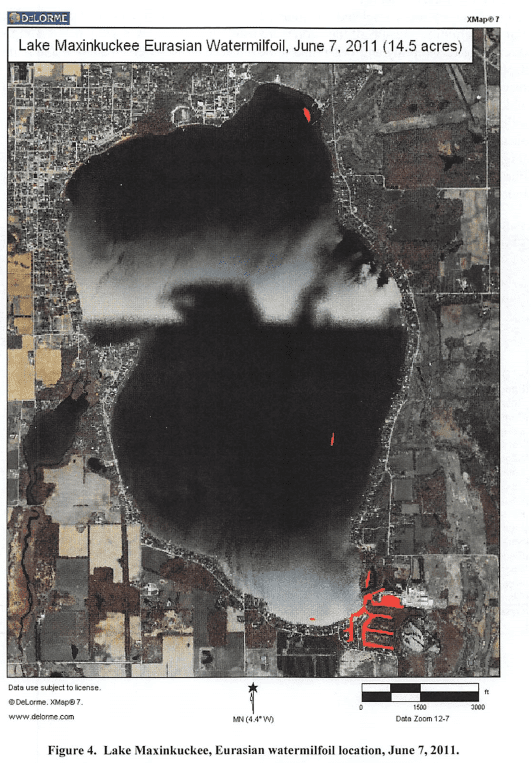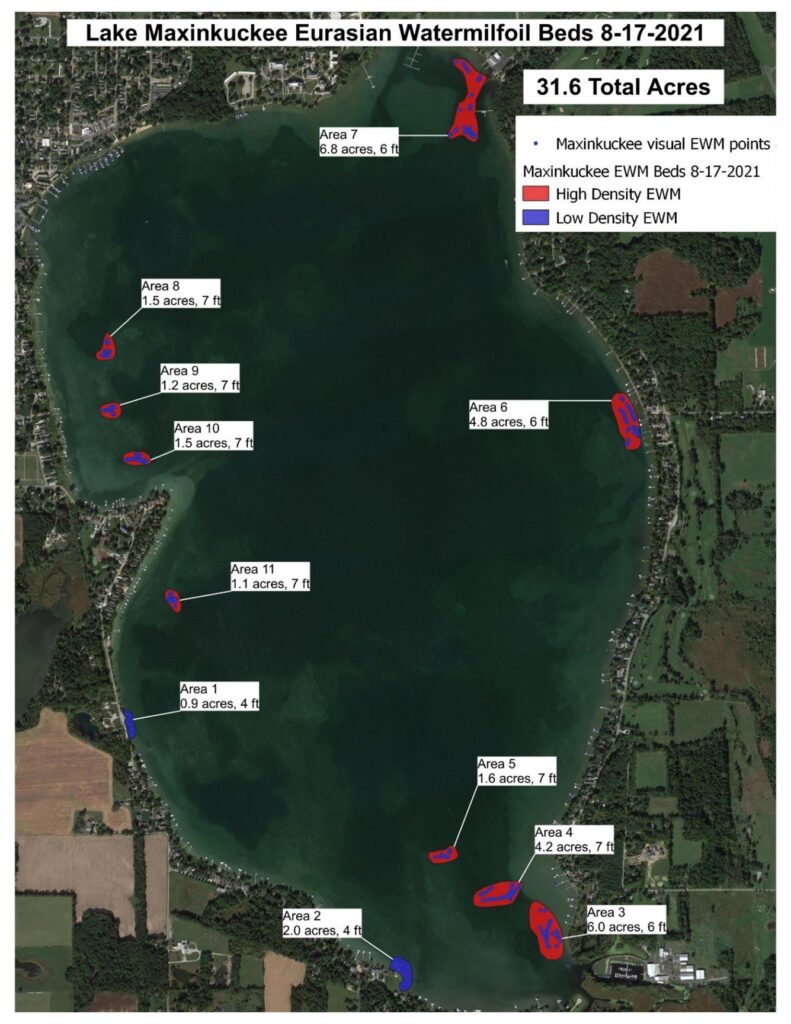Last year, Lake Maxinkuckee Environmental Fund (LMEF) paid for a survey of aquatic plants in the lake. The report showed a widespread infestation, encompassing approximately 32 acres, of invasive Eurasian watermilfoil (EWM) at multiple locations. This compares to a similar study done in 2011, which showed 14.5 acres of EWM in three very small areas in the lake itself, but primarily concentrated in the channels.


Why We Are Concerned
Eurasian watermilfoil is an aquatic invasive species that can grow into thick surface mats, especially in shallow areas, that interfere with swimming and boating activities and crowd out native fish and plant species. It is not native to North America and threatens the diversity and abundance of native plants as well as the ecological balance of a lake or pond.
What Should We Do?
The fact that the plants spread so easily, coupled with a growth rate of up to a foot a week in the summer months, makes this plant extremely invasive. If left unchecked, it will continue to spread throughout the lake and likely cause significant problems.
We consulted with Indiana DNR and a licensed private applicator for input. There are basically three methods of control available to us:
- Biological: Milfoil Weevil Augmentation. Did not find any recent or local success stories and many of the companies providing the weevils have gone out of business.
- Mechanical: Harvesting, pulling, dredging and bottom barriers. Expensive, slow results, not cost effective for widespread infestation.
- Chemical. Several success stories, both local to Indiana and throughout the US. Quick results, cost effective.
Case Study
Clear Lake Township Land Conservancy (CLTLC) was faced with a similar EWM problem. Their board reviewed treatment options, the same options the LMEF board considered, and through a scoring matrix based on safety, effectiveness and cost factors, came to the same conclusion:
Treating the lake with the selective herbicide, ProcellaCOR™, is the best course of action.
Bridget Harrison, Executive Director of CLTLC, presented on their decision-making process at the recent Indiana Lakes Management Society Annual Conference. I would be happy to share her presentation if anyone is interested.
Several other lakes, both local and throughout the United States, have documented their success with ProcellaCOR™.
Important to Note
While treating the lake with an herbicide is not without risk, ProcellaCOR™ is a very low risk option.
- It is a selective herbicide, meaning it only targets the EWM and won’t kill other native plants. The goal is not to kill all the vegetation, but to help native vegetation thrive.
- We must be approved for a permit by the DNR. Before any chemical treatments take place, the DNR biologists review the permit to ensure that the treatments will not be detrimental to the lake. There is a process of checks and balances to ensure the health of the lake.
- There is no wait time to use the lake after treating with ProcellaCOR™. That doesn’t mean I would swim behind the boat but you don’t have to stay out of the water or avoid fishing the day of treatment. However, you should wait a few days before watering your plants with water from the lake.
- We want a licensed, insured applicator, in collaboration with the DNR, addressing this issue, rather than homeowners trying to individually take care of their own shorelines.
Timing of Treatment
Treatment will probably be early June. The EWM has to be growing enough to absorb the herbicide. The applicator will come make a survey of the lake to confirm treatment areas and select a date. LMEF will be notified, and that information will be shared with the community. Areas where the chemical is applied near the shoreline are required to have notices posted on the property, but most of the treatment areas are not that close to the shoreline and won’t require this notification.
The health of Lake Maxinkuckee is of the upmost importance to LMEF. If you have concerns or questions, please feel free to contact the office via email lmec@lakemax.org, by phone 574-842-3686 or simply stop by.
Working toward the preservation of an ecologically sound Lake Maxinkuckee and its surrounding watershed.

Hi, I’m Debbie Palmer. I received a BS in Horticulture from Purdue University. Here at LMEF, I am responsible for outreach presentations, monitoring the lake and it’s wetlands, project manager for restoration and research projects, and act as a community resource for all things related to the well-being of Lake Maxinkuckee and its surrounding watershed. I completed Indiana Watershed Leadership Academy, volunteer with the Indiana Clean Lakes Program, Hoosier River Watch and Marshall County Lakes and Waters and serve as a Board Member for Indiana Lakes Management Society.


Recent Comments